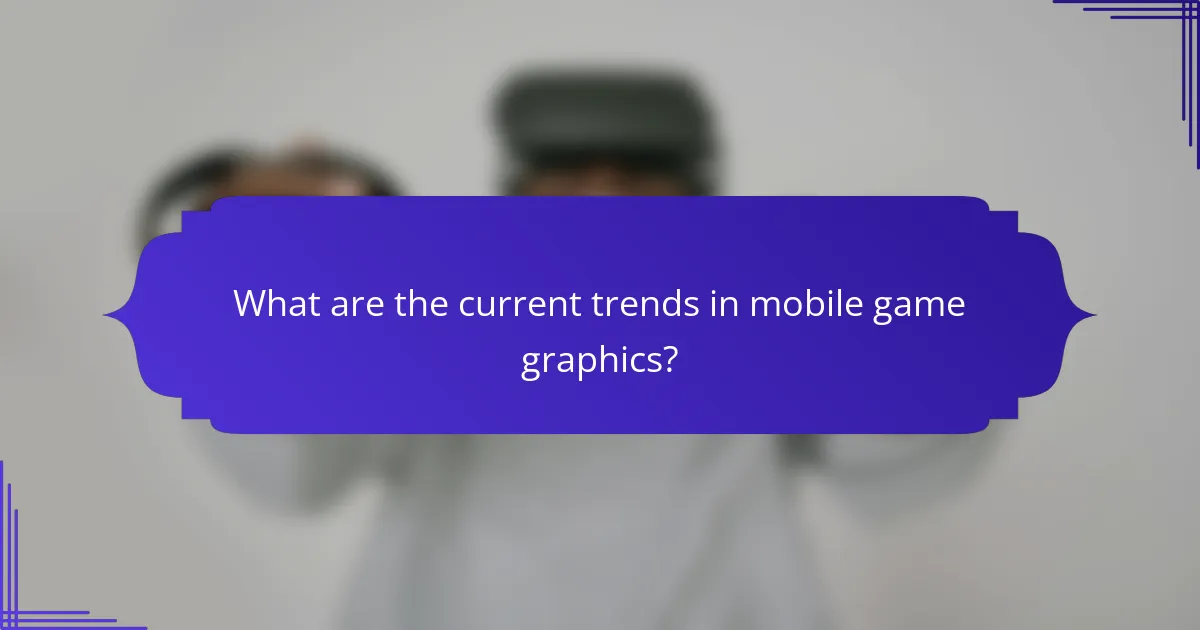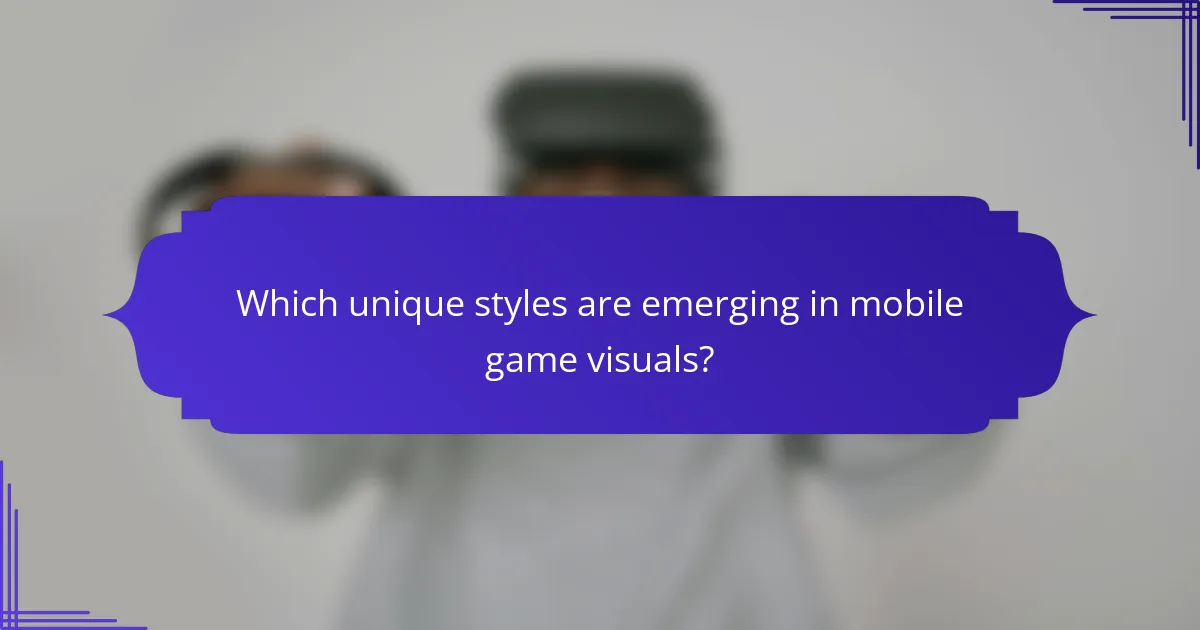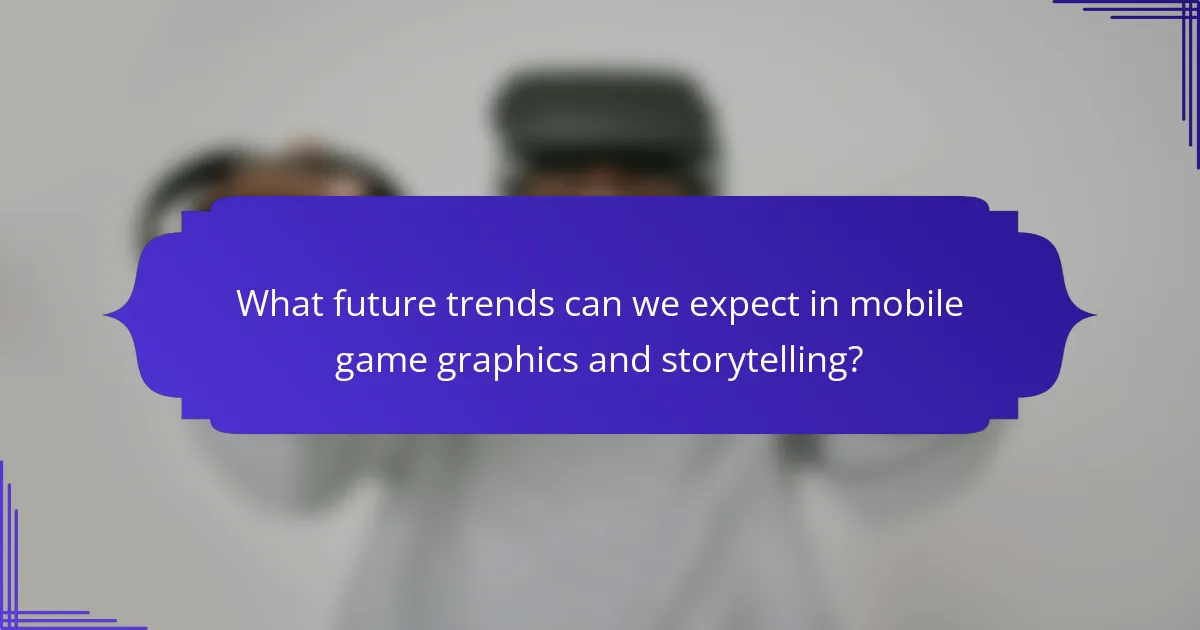Mobile gaming is rapidly evolving, with trends focusing on enhanced graphics and immersive visual storytelling. Current advancements include real-time ray tracing and augmented reality, which elevate user engagement. Developers are also addressing challenges like hardware limitations and design consistency to create dynamic narratives. Unique visual styles and player-driven choices are becoming essential for a captivating gaming experience.

What are the current trends in mobile game graphics?
Current trends in mobile game graphics emphasize realism, vibrant colors, and immersive visual storytelling. Advanced rendering techniques, such as real-time ray tracing, enhance lighting and shadows, creating a more lifelike experience. Additionally, stylized graphics remain popular, offering unique artistic expressions. The integration of augmented reality (AR) further elevates user engagement, blending digital elements with the real world. As a result, mobile games increasingly prioritize visual fidelity and narrative depth to attract diverse audiences.
How do mobile game graphics enhance user engagement?
Mobile game graphics significantly enhance user engagement by creating immersive experiences. High-quality visuals attract players, making gameplay more enjoyable. Enhanced graphics also facilitate storytelling, allowing developers to convey narratives effectively. As a result, players feel more connected to the game world, increasing retention and satisfaction. Unique visual styles can differentiate games, making them memorable and encouraging social sharing.
Which technologies are driving advancements in mobile graphics?
Advancements in mobile graphics are primarily driven by technologies like real-time ray tracing, AI-enhanced rendering, and improved GPU architectures. These innovations enhance visual quality and performance in mobile gaming. Real-time ray tracing provides realistic lighting and shadows, while AI algorithms optimize rendering processes. Additionally, powerful GPUs enable richer textures and complex visual effects, elevating the overall gaming experience.
What role does 3D rendering play in mobile games?
3D rendering enhances mobile games by creating immersive environments and realistic characters. This technology elevates visual storytelling, making gameplay more engaging. High-quality graphics draw players in, improving retention and satisfaction. As a result, developers increasingly adopt advanced rendering techniques to meet player expectations.
How are mobile graphics optimized for different devices?
Mobile graphics are optimized for different devices by adjusting resolution, texture quality, and rendering techniques. Developers ensure that graphics maintain performance and visual fidelity across varying hardware capabilities.
Key optimization techniques include adaptive resolution scaling, where the game adjusts graphics quality based on device performance. Additionally, texture compression methods reduce file size without significant visual loss.
Unique attributes like device-specific shaders enhance visual effects tailored to the capabilities of particular hardware. As a result, mobile games can provide immersive experiences on both high-end and budget devices, catering to a wider audience.

How is visual storytelling evolving in mobile gaming?
Visual storytelling in mobile gaming is evolving through enhanced graphics, immersive narratives, and interactive elements. Developers are leveraging advanced technologies like augmented reality and artificial intelligence to create dynamic storytelling experiences. As a result, players engage more deeply with characters and plots, fostering emotional connections. Unique attributes like personalized storylines and player-driven choices are becoming essential, making each gaming experience distinct.
What techniques are used to create immersive narratives?
Immersive narratives in mobile gaming utilize techniques like interactive storytelling, environmental storytelling, and character-driven narratives. These methods engage players by allowing them to influence outcomes and explore richly designed worlds.
Interactive storytelling enables players to make choices that affect the game’s direction, enhancing emotional investment. Environmental storytelling uses visual cues and details in the game world to convey backstory and context without explicit exposition. Character-driven narratives focus on deep character development, making players care about the characters’ journeys and decisions.
These techniques combine to create a cohesive narrative experience that keeps players engaged and invested in the game.
How do character designs influence storytelling in mobile games?
Character designs significantly enhance storytelling in mobile games by creating emotional connections and conveying narrative themes. Unique character attributes, such as visual style and personality traits, influence player engagement and immersion. For instance, a well-designed character can embody the game’s core themes, guiding players through the story. Additionally, character interactions and development can reveal plot twists and deepen player investment. Overall, effective character design serves as a visual storytelling tool that enriches the gaming experience.
Which games exemplify innovative visual storytelling?
Games like “Gris,” “Journey,” and “Oxenfree” exemplify innovative visual storytelling through unique art styles and narrative techniques. “Gris” uses watercolor aesthetics to convey emotional depth, while “Journey” employs minimalistic design to enhance player connection. “Oxenfree” integrates dialogue choices with striking visuals, creating an immersive experience. These titles showcase how mobile gaming can push the boundaries of visual narrative.

What are the challenges faced in mobile game graphics and storytelling?
Mobile game graphics and storytelling face significant challenges, including hardware limitations, design consistency, and narrative depth.
Hardware constraints limit the graphical fidelity and realism achievable on mobile devices. Developers must optimize visuals to ensure smooth performance across various devices.
Design consistency is crucial for maintaining player immersion. Inconsistent art styles can detract from the overall experience, making it harder for players to engage with the story.
Narrative depth often suffers due to shorter play sessions typical of mobile gaming. Developers must craft compelling stories that fit within these time constraints while still providing meaningful choices and character development.
These challenges require innovative solutions to enhance the mobile gaming experience significantly.
How do budget constraints affect visual quality?
Budget constraints significantly limit visual quality in mobile gaming. Developers must prioritize resources, often resulting in lower resolution textures and simplified graphics. This can affect player immersion and storytelling, as detailed visuals enhance narrative engagement. As mobile devices advance, players expect higher standards, creating a challenge for developers balancing costs with quality.
What are the common technical limitations in mobile graphics?
Common technical limitations in mobile graphics include processing power, memory constraints, battery life, screen resolution, and compatibility issues. These factors restrict the quality and complexity of graphics in mobile gaming.
Processing power in mobile devices is generally lower than in consoles or PCs, limiting real-time rendering capabilities. Memory constraints can hinder the amount of high-resolution textures and assets that can be utilized. Battery life is a critical concern; high-quality graphics can drain power quickly, impacting gameplay duration. Screen resolution varies among devices, which can affect visual fidelity and consistency. Compatibility issues arise from different hardware specifications and software versions, making it challenging to optimize graphics across all devices.
How does user feedback shape graphic and storytelling choices?
User feedback significantly influences graphic and storytelling choices in mobile gaming. Developers analyze player responses to enhance visual aesthetics and narrative depth. This iterative process ensures that graphics resonate with player preferences, improving engagement and retention. For instance, feedback on character design may lead to more relatable features, while narrative critiques can refine plot elements. Ultimately, this responsiveness to user insights fosters a dynamic gaming experience that evolves with player expectations.

Which unique styles are emerging in mobile game visuals?
Emerging mobile game visuals showcase unique styles that blend realism with artistic expression. Key trends include vibrant colors, minimalist designs, and retro aesthetics. Developers increasingly use 3D art and dynamic lighting to enhance immersion. Unique visual storytelling techniques, such as hand-drawn animations and interactive environments, create captivating player experiences.
What are the defining features of popular art styles in mobile games?
Popular art styles in mobile games often feature vibrant colors, stylized characters, and immersive environments. These styles enhance visual storytelling and engage players effectively.
Key defining features include:
– **Stylization**: Many mobile games adopt exaggerated character designs and environments to create a unique aesthetic.
– **Color Palette**: Bright and contrasting colors are common, attracting players’ attention and conveying emotions.
– **Animation Quality**: Smooth animations enhance the gameplay experience, making interactions feel more dynamic.
– **User Interface Design**: Intuitive and visually appealing interfaces contribute to user engagement and ease of navigation.
These attributes collectively shape the visual identity of mobile games, influencing player experience and retention.
How do cultural influences shape visual aesthetics in games?
Cultural influences significantly shape visual aesthetics in mobile games by integrating unique artistic styles and storytelling methods. For instance, games often reflect cultural symbols, color schemes, and design principles, enhancing player immersion. As a result, diverse cultural backgrounds lead to varied visual experiences, appealing to global audiences. This trend fosters innovation in graphics, making mobile games visually distinct while promoting cultural appreciation.

What future trends can we expect in mobile game graphics and storytelling?
Mobile gaming will see advanced graphics and immersive storytelling. Expect trends like real-time ray tracing, enhanced 3D environments, and AI-driven narratives. These innovations will deepen player engagement and create visually stunning experiences. As mobile devices evolve, the graphics will rival console quality, while storytelling will integrate player choices in dynamic ways.
How will augmented reality influence mobile gaming experiences?
Augmented reality will significantly enhance mobile gaming experiences by creating immersive and interactive environments. Players will engage with their surroundings, blending real and virtual elements. This integration will elevate visual storytelling, making narratives more impactful and personal. Enhanced graphics and real-time interactions will lead to deeper emotional connections to characters and stories. As a result, mobile games will offer unique gameplay experiences that adapt to individual environments.
What advancements in AI are shaping the future of graphics?
Advancements in AI are significantly enhancing graphics in mobile gaming. Techniques like real-time ray tracing and AI-driven upscaling improve visual fidelity. AI-generated content enables dynamic storytelling, adapting narratives based on player choices. Additionally, machine learning algorithms optimize graphics rendering, ensuring smoother gameplay and richer environments. These innovations collectively elevate the gaming experience, making it more immersive and visually stunning.
Which platforms are expected to lead in mobile gaming innovations?
Mobile gaming innovations are expected to be led by platforms like Apple Arcade, Google Play Pass, and cloud gaming services. These platforms prioritize advanced graphics and immersive storytelling. Apple Arcade focuses on exclusive titles with high-quality visuals, while Google Play Pass offers a diverse range of games enhancing visual experiences. Cloud gaming services, such as NVIDIA GeForce NOW, enable high-fidelity graphics on various devices, promoting accessibility and innovation in mobile gaming.
What best practices should developers follow for effective graphics and storytelling?
Developers should prioritize high-quality graphics and cohesive storytelling for mobile games. Key best practices include optimizing performance to ensure smooth gameplay, using visually appealing art styles that match the narrative tone, and integrating character development into the visual elements. Additionally, employing dynamic animations can enhance emotional engagement. Crafting a seamless user experience through intuitive interfaces is essential for maintaining player immersion.
